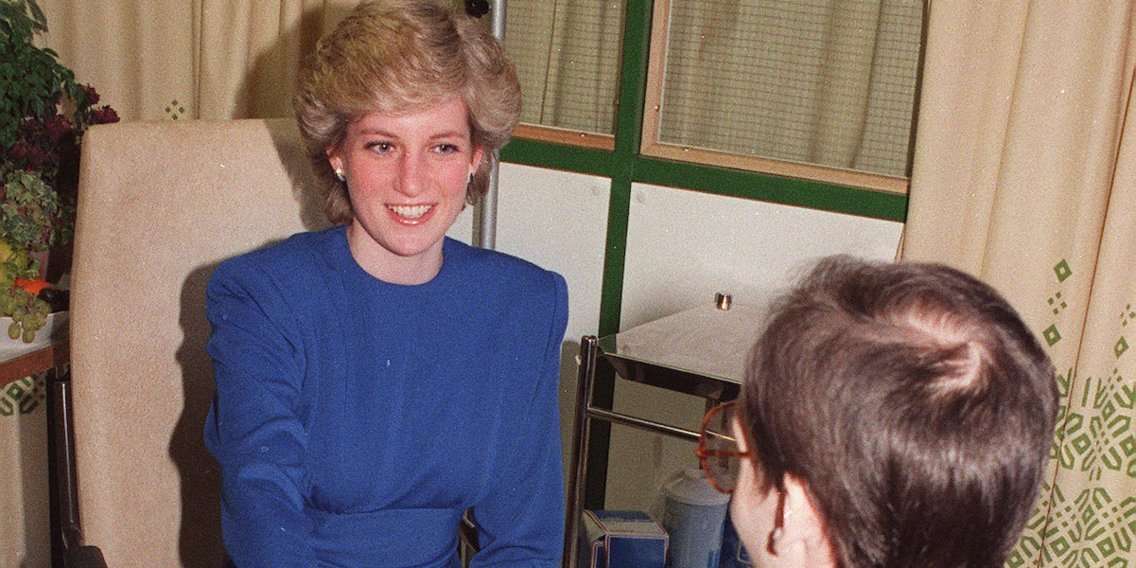Diana shakes hands with an unidentified AIDS patient on April 19, 1987. John Redman/AP
In 1987, Princess Diana of Wales visited AIDS patients at a hospital in London.
A famous photograph shows her shaking a patient's hand without wearing gloves.
The gesture challenged the once-common (but incorrect) belief that HIV or AIDS could be transmitted by touch.
The moment is emblematic of Diana's unwavering compassion for other people.
Today marks 20 years since the death of Princess Diana — a woman who's remembered as a style icon, loving mother, unconventional royal, and champion of charitable causes.
One of her finest humanitarian moments took place in a single instant on April 19, 1987.
That day, Diana arrived at London Middlesex Hospital to open the UK's first unit dedicated to treating people with HIV and AIDS, the BBC reported.
Then, she did something that history would remember forever: She shook the hand of an AIDS patient without wearing gloves.
Today it may not seem remarkable, since we know that HIV — the virus that can lead to AIDS— can't be transmitted by handshakes. But things were very different just a few decades ago.
Princess Diana speaks with an AIDS patient in 1991. Hans Deryk/AP
AIDS was first identified back in the early 1980s. By 1983, scientists at the CDC had already concluded that the disease could not be transmitted through casual contact, but the public had become terrified. Reports from that era tell heartbreaking stories of AIDS patients — even children — who were shunned and stigmatized because of the disease. In 1985, the Los Angeles Times conducted a poll and found that 50% of respondents favored quarantining people with AIDS.
When she shook the hand of an unidentified AIDS patient, Diana used her public platform to challenge that irrational fear.
Princess Diana hugs an HIV-positive child in 1991. Dave Caulkin/AP
"If a royal was allowed to go in shake a patient's hands, somebody at the bus stop or the supermarket could do the same," a nurse who witnessed Diana's hospital visit once told the BBC. "That really educated people."
Diana didn't get the nickname "the people's princess" by accident: In her life she was a president or patron of more than 100 different charities working across a range of important issues. Her humanitarian work didn't begin or end with that handshake.
But in that moment, Diana showed the depth of her compassion for others. And she did it in a way that speeches and PSAs and TV interviews never could: She led by example.

xcasandraXspenderx on July 18th, 2018 at 14:07 UTC »
My uncle died of AIDS in 1999, came out in the 70s. My mom and dad both had lots of gay friends, the best man their weddings was my dads college roommate and best buddy, who also died in the 80s from it. It was fucking brutal. I have grown up with a very graphic description of what happened to people with it, and the graphic nature of how much they were discriminated against, it was terrible. My grandma said she went with my uncle to a few of his friends deaths, and they would just find some street drugs to overdose when they started to get sick back then. There was no help for these people, ffs their families wouldn’t touch them. Can you imagine the terror of being so sick of a disease that you don’t understand, and your family is instructed to not touch you? People assumed it was like Ebola and with the way lgbt was treated in general back then, it must have a been completely terrifying and heartbreaking way to die. Also, you got sick quickly. The government did not care.
I’ve always admired Princess Diana, but her reaching out to this community is by far the coolest and best thing she did in my opinion, even over the landmines(but that was really really amazing also). Truly the people’s princess. We need more people like her.
Gisschace on July 18th, 2018 at 13:41 UTC »
Here is a video of her with Barbara Bush meeting AIDS patients. It might be hard for us to comprehend now but this was during a time when patients own families wouldn't touch them. Note how they deliberatly showed them sitting close to and shaking hands with the patients so that the press had to use these pictures. She did the same with Leprosy victims.
https://www.youtube.com/watch?v=AZwa-0g-kFw
Edit: This video from one of the nurses of the ward looking back in which he talks about the significance of the visit and the attitudes of the time. He explains he didn't even tell people what his job was, not even other Drs and Nurses, because of the stigma attached to Aids https://www.bbc.co.uk/news/av/magazine-39490507/how-princess-diana-changed-attitudes-to-aids
Ivyleaf3 on July 18th, 2018 at 13:33 UTC »
I was 13 when this was published. School friends swore you could get AIDS from toilet seats (just any perfectly clean looking seat, not even one spotted with HIV+ blood), sharing a drinking bottle or cutlery, kissing. And at that point in time it really was a death sentence and a horrible way to go, too. It's not possible to underestimate how much of a statement this was to people whose main source of information was rag media.